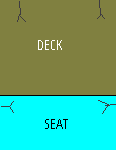
For this discussion seats and decks are that portion of furniture support that lies under loose cushions. As opposed to the "tight" seat we showed you in the How To Upholster A Chair segment. Study that information for more detail about making the "V" cuts, shown at left, for going around the frame. A strong but cheaper fabric called decking or deck liner is used to conserve the fabric that the seat and the rest of the chair is covered in. Cut the decking piece large enough so that you can get a grip on it when you tack it down. This illustration at left is the simplest, the decking and seat material are sewn together with a 1/2" seam.

This chair, in this case for a "T" shaped cushion, has the most common type of seat. You should be able to cut a seat like this without using a pattern from the old seat. In many cases it unnecessary to remove the old seat (some states require all old fabric to be removed). Remember that professional upholsterers only use patterns if it will speed up a job not slow it down. The ends of this particular seat are tacked to the outside arm frames after the inside arm material is installed. Of course, the rest of the seat and deck are put on first.

Here we show the new seat, half sewn, laying on the cutting table. Don't forget to add on your seam allowances before cutting. Measure from the center and mark your cutouts.

Here's another type of seat usually found on furniture with coil springs. The seat ends are not attached to the arm at all but allow the seat to move freely up and down. Watch for this so that you don't cut your seat material too short from side to side. Which brings us to a special handsewing technique used only on seats. Because of the up and down motion placed on seats and to help prevent the cushions from sliding forward the seat should be sewn down along the seam between the seat material and deck material. It's recommended to do this on all jobs with coil springs. If the piece you are working on has no-sag springs or a webbed seat you might not have to pull down the seat at all on some chairs. All sofas and some chairs need to be pulled down either by sewing or by putting in a row of buttons. The buttons can be spaced maybe 6-10" apart. This prevents the seat from wrinkling. See making and installing buttons segment.

We're using a 6" curved needle and button twine to sew down this seat. First place the deck and seat pieces on the furniture with the fitted front of the seat in place. Fold back the deck fabric towards the front of the seat. Catch a bit of the seam and the old cover (or spring) and tie a slip knot. Next you'll need to insert the needle through the old deck padding to the left going under one side or other of the top rung of a spring.

Next go back to the right and insert the needle and go beyond the previous stitch to the left. Note the long stitches in the photos. Tie off your twine at the ends when you are done.
Finally, pad the deck with a layer or half layer of cotton or bonded
polyester then tack down. Do the same for the seat.
